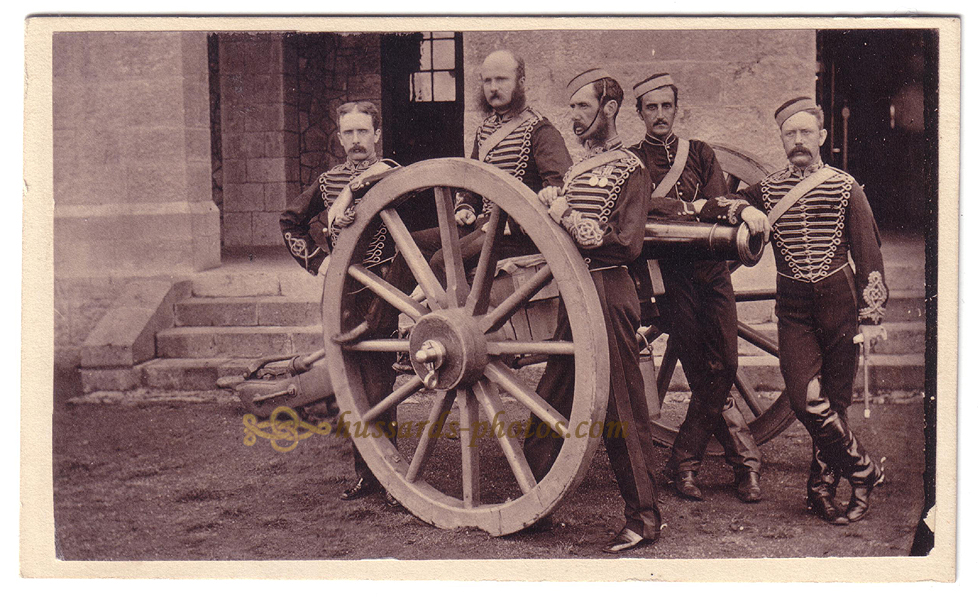| Superb 1860s carte-de-visite displaying
five officers from the Royal Horse Artillery around a gun.
The officers are, from left to right :
- A lieutenant, as is shown by his
simple cuff braiding and the Crown on his collar
- Another
lieutenant
- A Captain ; he is wearing two
campaign medals ; the one on the right is the Indian Mutiny
(1857-59) medal (one clasp) ; the one on the left is the Indian General
Service 1854 Medal (one clasp)
- A third
lieutenant
- Another Captain (with specific cuff braiding, and Crown and Pip
on collar) ; he's wearing the riding overalls .
This
Carte de Visite shows the Officers of a Battery of Royal
Horse Artillery ; the typical establishment of a Battery in the
1860s consisted
in two Captains (one of them being a Second Captain) and three Lieutenants or
Second Lieutenants, in charge of two guns each. The
Captain on the right is George William
Borradaile, who was promoted to Second Captain on August 3 1865. On
this photograph he is wearing the booted overalls that will be
suppressed in 1871.This Carte de Visite, taken in India, thus dates
from the mid. to late 1860s. At the time he was serving with A
Battery, E Brigade, RHA. The
decorated officer in the center of the photograph is Captain
Thomas Marshall Harris.
A Cadet of the HEIC in 1845-46, he joined the Bombay Artillery as a 2d Lieutenant on June 11 1847,
and promoted to 1st Lieutenant on August 15 1852. In 1856 he was
attached to the 3rd Troop (Blake's) Bombay Horse Artillery that
took part in the Persian Expedition. He served in the capture of
Reshire, surrender of Bushire, and bombardment of Mohumrah. The
campaign was short lived (on the photo Captain Harris is
displaying his India General Service Medal with "Persia"
Clasp - medal on the left), but the British Forces had scarcely
come back to India that the Mutiny broke out. Blake's
Troop served in Central India ans was attached to General Robert's
Force in January 1858. Lieutenant Harris took part in the siege of
Kotah (March 24th to 30th, 1858) and pursuit. On June 17th he was present
at Kotah-ke-Serai, where the famous Rhanee of Jhansi, disguised as
a man, was killed in a charge of the 8th Hussars. That action was
immediately followed by the Battle and capture of Gwalior (June 19th-20th), where he was mentioned in despatches.
The 3rd Troop Bombay Horse Artillery formed part of the
reinforcements led by Brigadier Napier from Gwalior to Paori when
Maun Sing seized it. The siege lasted two days (August 20th-21st)
before the rebels fled ; Second Captain Harris (he was promoted on
August 27th 1858) did not take part in the following affair at
Bijepur, where the two guns of the Battery that had taken part in
the pursuit of the rebels where commanded by Lieutenant
A.R.Hoskins. This is the only action of the Battery he did not
take part in.
He may however have commanded the Battery on October 9th, at the
action of Sindwaho (not included in Colonel Blake's services),
where Brigadier Michel's troops (reinforced by Smith's Brigade)
opposed the Nana Rao and the Nawab of Banda, who protected
the fords of the Jumni. The salvos of case shot of the Troop were
instrumental in the decision of the action, that was immediately
followed by another action at Kurai, still in the pursuit of
Tantia Topee.
He was again involved with Smith's Force on November 14, where
they again met a reappearing Maun Sing at Kundri. Lieutenant
Harris was severely wounded in the action. He was awarded the
Indian Mutiny with Clasp Central India (on the right). Thomas
Marshall Harris was transferred to the Regiment of Royal Artillery
at the 1861 amalgamation. He was gazetted a Captain on April 23rd,
1863 (dated October 21st 1862).
On April 18th, 1864, he is appointed from the 18th Brigade to
the command of A Battery, 4th Horse Brigade (late 1st Troop,
Bombay Horse Artillery). The following month the Brigade was
renamed E Brigade. He will remain in command of the Battery (transferred
to D Brigade when the E Brigade was reduced in 1871, and renamed C
Battery D Brigade) until October 25th, 1872, when he will be
successed by Major W.W.Woodward.
Captain harris had been made a
Major on July 5th 1872, when the regimental rank was reinstated in
the Regiment of Artillery, and immediately thereafter promoted to
Lieutenant-Colonel (gazetted August 6th 1872, dated August 1st). In 1875 he is Assistant Adjutant of
Artillery, Bombay.
He was gazetted back Lieutenant-Colonel from the Supernumerary
List on April 13th 1875 (dated April 1st)
He'll be promoted to Colonel on August 1 1877.
In 1880 he is posted to 7th Brigade. He will retire with the rank
of colonel, "upon a pension, with extra annuity, dated 1st
October, 1882". That
photograph was probably taken in the late 1860s, when both Harris
and Borradaile were Captains. The last station of the Brigade in
India was Ahmednuggur (left in 1872), and that may be the place
where the photograph was taken.
The identity of the Lieutenants are unknown. Many
thanks to James Hanafin
|

